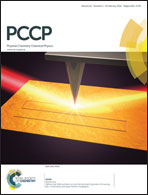Significant enhancement in the thermoelectric performance of strained nanoporous Si
Abstract
Increasing demand for energy with fossil fuel supplies decreasing makes it an urgent task to develop novel and cost-effective materials that can supply environmentally benign and sustainable energy. To address this important issue, in the present work we carry out a systematic study on the effect of external strain on the room-temperature thermoelectric properties of Si containing cylindrical pores in a periodic arrangement (nanoporous Si, or np-Si), based on density functional theory and the Boltzmann transport equation. Within the relaxation time approximation, it is demonstrated that the electrical conductivity (σ) and Seebeck coefficient (S) of np-Si remain unchanged from the strain-free values under biaxial or shear strain. However, orthorhombic strain increases σ and S by as large as 68% and 110% compared to the unstrained structure, respectively, which is found to originate from the broken planar symmetry induced by the applied strain. Combined with the thermal conductivity, the improvement in σ and S of orthorhombically strained np-Si can enhance the maximum value of the thermoelectric figure of merit to as high as 0.8, which makes strain engineering particularly attractive for high-performance thermoelectrics.


 Please wait while we load your content...
Please wait while we load your content...